After spending Friday night drinking in the Easington Working Men’s Club I was reminded of Chris Coekin’s fabulous body of work Knock Three Times: Working Men, Social Clubs and Other Stories.Â
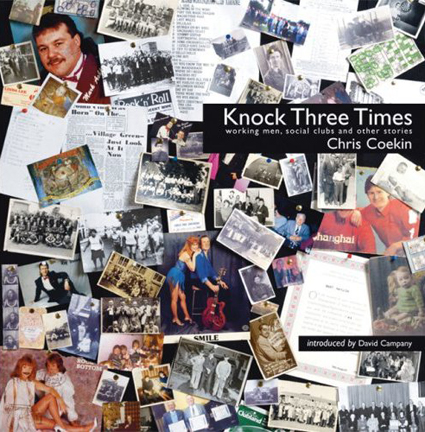
Chris’s family has a long tradition of socialising in Working Men’s Clubs. As a child Chris was taken to many clubs in his hometown of Leicester and during family holidays around England. Many of these clubs have long since disappeared. Working Men’s Clubs were originally set up for the support and education of the working man. Knock Three Times is set in the Acomb WMC York where Chris first photographed in 1996. The club, and its members, symbolise the working class community at large.Â
“Using metaphorically driven images and archive ephemera, Chris explores his cultural roots and identity. The vivid, ambiguous, and often autobiographical images reflect his recollections of visiting WMCs as a child. They interrogate the complexities associated with growing up within a working class culture, ideas of masculinity, relationships and its work ethic. The notion of ‘common sense’ provides the foundation for a narrative that looks beyond the surface appearance of WMCs.” As quoted on Chris’ profile page of the University College for the Creative Arts in Rochester, where he lectures.
You can see a slideshow of the work see showcase of the work here and read a review on Jörg Colberg’s weblog here.
Â
Posted in MISCELLANEOUS | Comments Off on KNOCK THREE TIMES
During a visit to Middlesbrough last week I came across six pubs in one day that were either boarded up or had ‘for sale’/ ‘pub to let’ signs up outside, such as the Brambles Farm on Cargo Fleet Lane.
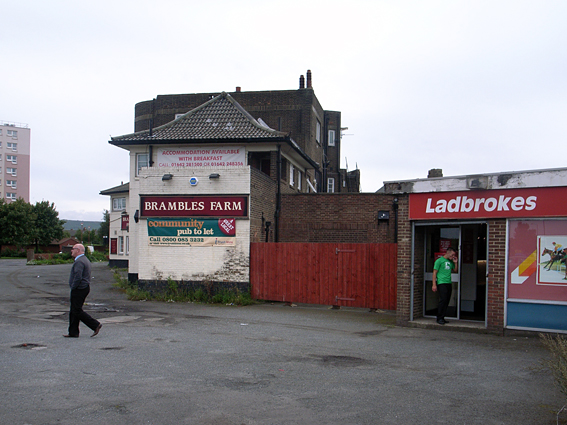
While there are approximately 57,500 public houses in the UK with one in almost every city, town and village, statistics compiled by the British Beer and Pubs Association found that 27 pubs a week closed in 2007 – seven times faster than the previous year and 14 times faster than 2005. This means that four a day are closing in a country where the pub has been an integral part – some might say essential part – of social, cultural and business life for centuries. (Follow this link for a short history of the pub).
In many places, especially in villages, a pub can be the focal point of the community, playing a complementary role to the local church in this respect. The writings of Samuel Pepys describe the pub as the heart of England and the church as its soul.
So why are pubs in trouble? Publicans and landlords talk about rising rent, rates, fuel, property, taxation, lower disposable income (thanks to higher household bills and mortgages), the smoking ban, the trend towards wine drinking, and fierce competition from off-licences, newsagents and supermarkets. Pubs have also suffered from the abundance of alternative leisure pursuits available these days – fifty years ago the choice would have been the cinema, dance hall or a few sporting events. However, somewhat surprisingly given the almost daily headlines of the British binge drinking culture, as a nation we’re actually drinking less. According to the BBPA, average consumption is down 15 per cent on 2000.
One place where I didn’t find much evidence of a slow-down in drinking was Easington Working Men’s Club in Easington Colliery, County Durham, where we enjoyed a pint on Friday night. The place was packed with a full house for bingo and quiz night.
Â
Posted in MISCELLANEOUS | Comments Off on LAST ORDERS
On the subject of greyhound racing (see my last post on Walthamstow Stadium) I came across this intriguing photograph from the Times Archive titled ‘Keeping the dogs up to scratch’. The caption reads: All on a summer’s days, girls from the greyhound kennels in Wandsworth, southewest London, put some of the dogs through their paces over hurdles in August 1939.
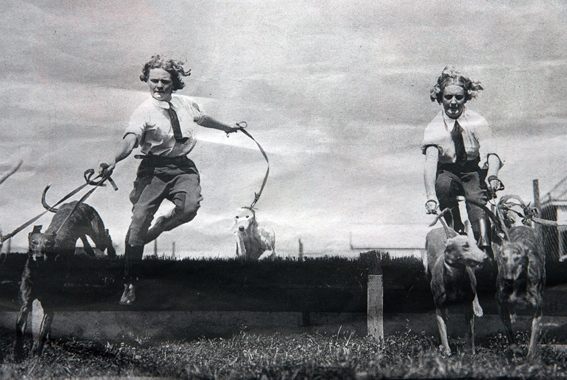
Â
Posted in EVENTS & PASTIMES | Comments Off on KEEPING THE DOGS UP TO SCRATCH
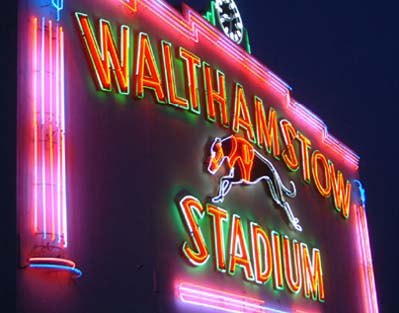
“Walthamstow Stadium is now Closed
The last race greyhound meeting was held at the stadium on Saturday 16th August 2008.
The Chandler Family would like to take this opportunity to thank all their staff & customers for 75 years of great service.â€
This is the notice that now appears on the homepage of Walthamstow Stadium’s website. It’s incredibly sad to hear that the greyhounds raced around Walthamstow Stadium, in northeast London, for the final time on Saturday night.Â
The closure of Walthamstow now leaves Britain with 29 registered greyhound tracks, and London with only one – Wimbledon. At the sport’s postwar peak, 50 million a year packed into 77 tracks. But the shift to betting in shops and online has hit tracks hard. Despite £2.3 billion a year gambled on greyhounds, turnover at the Walthamstow tote fell from £16.85 million in 1989 to £8.76 million last year. Before the sale was announced three months ago, attendance at the Stow had slumped to a couple of thousand on Saturday and a couple of hundred on a wet Tuesday.
The Stow, as it was affectionately known, was built in 1933 by William Chandler, a street-corner bookmaker, and had been owned by his family until its sale this year to property developers and a housing association for an undisclosed sum. The decision caused a lot of bad feeling, but the Chandlers point to losses of more than £500,000 for the year ended February 2008. Charles Chandler, the company chairman, said that he was deeply upset, but the business had become unsustainable.
The early appeal of greyhound racing to Britain’s working men is easy to explain, says Lord David Lipsey, a Labour peer and chairman of the British Greyhound Racing Board: “At that time, a working man couldn’t get a legal bet except at a dog track – he couldn’t get credit at a bookmakers. Greyhound tracks were also a lot cheaper to get into than racetracks, and far easier to get to.” The sport, Lipsey says, is “deeply embedded in a certain kind of cultural life.” Even before it closed, entrance to a weekday night of racing in the Popular Enclosure at Walthamstow is yours for a quid (and free for under-15s).
TS Eliot argued, in Notes Toward a Definition of Culture, that for a nation’s culture to be truly complete it must be composed of the high and the popular variety – of Derby Day at Epsom, the Glorious 12th, and a night at the dogs.
North London has lost a place of popular culture to be replaced, no doubt, by a bland housing estate which will offer little to the local community.
Â
Posted in EVENTS & PASTIMES | Comments Off on END OF THE STOW
In a recent post, Jennifer Hodgson, a commentator on English culture, observed what she considered to be the anachronistic nature of this project. She thought that the events I had chosen to photograph, and the components that constituted them, were archetypally English, drawing on nostalgic visual codes and serving to underline an imagined view of England, one that was not necessarily rooted in contemporary reality. This raises many interesting questions.Â
Firstly, perhaps there is the presumption that any attempt to record Englishness is part of an attempt to re-construct it or re-define it, as opposed simply to recording what one finds. In other words, I don’t have an agenda, as Tony Ray-Jones did, for example, when he set out in the late 1960s to record the English way of life before it became more Americanised.Â
Indeed, a selection of the ideas for this project have come from my website, where people have posted up their suggestions of events for me to photograph. This is important, as the photographs reflect a generalized, hopefully widespread visualization of England, not just my own vision. These events do, however, reflect people’s conception of and notion of Englishness. Many of them are traditional fetes, fairs, races and sports activities, which can appear rather mundane, or unimaginative; English life at its most predictable and stereotypical. But this is not a kind of unconscious national attempt to consolidate a frail notion of English identity. It is, I believe, a simple reflection of local life for the majority of people.Â
On the whole, people are doing what they have always done; they congregate in open spaces, on the beach or beside lakes and rivers, they eat food and drink and spend time with friends and family. They play sport and listen to music; they really do converge on the village green or the nearest playing field. Seen from this perspective, we may appear, as a nation, to lack diversity in terms of how we express our preferences and interests. Additionally, there are a number of traditional English elements to an event, for example, Punch and Judy shows or Morris Dancing that are enjoying a revival. The current enthusiasm for fetes, fairs and festivals is a reflection of changing fashions and such events are definitely in vogue once again.
This is my personal, grass roots experience. There is no doubt, however, that county councils and large organizations are utilising traditional ideas and references to market their events. This is a point that I want discuss in more detail in a later post, however, I just want to highlight one such example now. In many ways the Gloucestershire cheese rolling festival could be seen as an extreme example of Englishness being bottled and branded, with television coverage, a press compound and a £300 fee just for a photographer like me to record the event. I chose not to do so because I felt uneasy with the cynical self-consciousness on the part of the organizers to present the world with what they believed was typical Englishness (or maybe the event has just become a victim of its on success). Clearly, the cheese rolling has become a media circus and bares very little relation to ‘normal’ life.
Â
Posted in ENGLISHNESS, EVENTS & PASTIMES | Comments Off on AN ANACHRONISTIC APPROACH?
We’re in the coastal town of Whitby in North Yorkshire and yes, it’s raining. Heavily. So what to do?
Brave the rain?
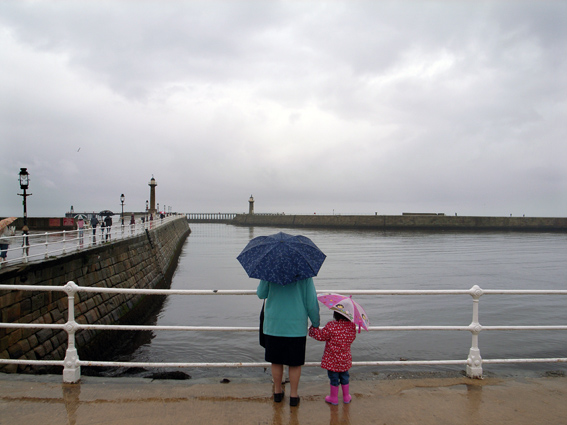
Â
Visit the amusement arcades?
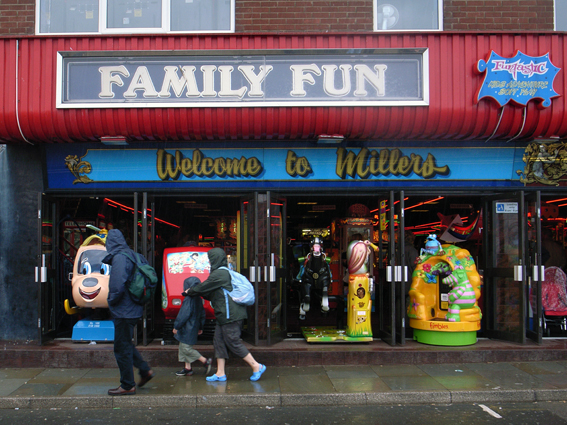
Â
Or watch a dance?
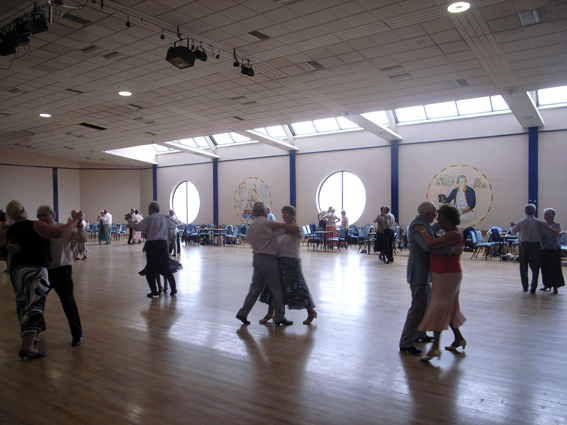
Â
I opted for the latter and went along to an afternoon tea dance at Whitby Pavilion to watch local retirees fox trot and tango to music played by Ray Kirk.  It was a wonderful sight, which reminded me of a series of photographs I made in Arizona on the Snowbirds.Â
Â
Posted in PLACES | Comments Off on WHAT TO DO ON A WET DAY IN WHITBY?
Rather amusing poster outside Silks nightclub in Redcar-
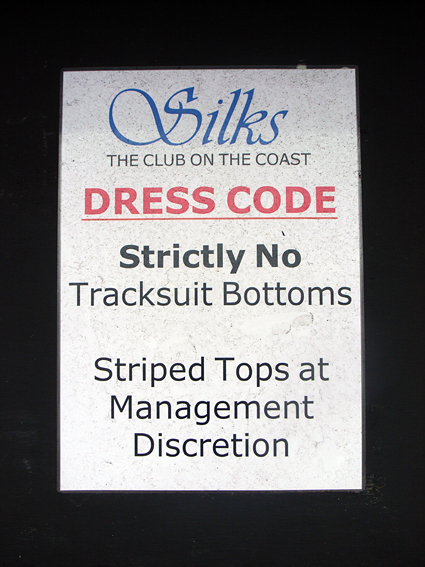
Posted in POSTCARDS | Comments Off on STRICTLY NO TRACKSUIT BOTTOMS
Continuing my weekly dispatch in The Times, week 11 was taken in Uttoxeter, Staffordshire (although, thanks to extended coverage of the Olympics, the picture won’t actually be appearing in the newspaper this week!).
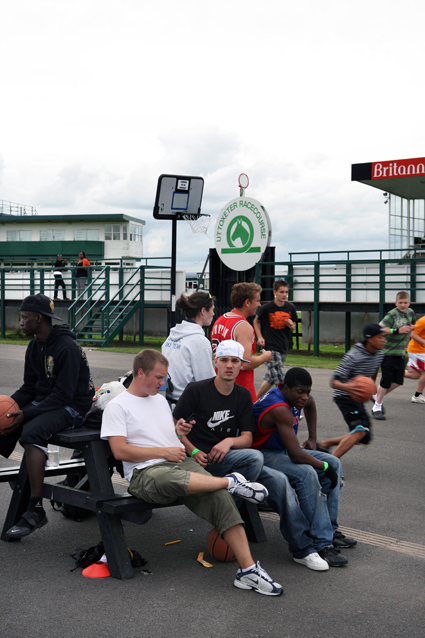
Uttoxeter Race Course, 4th August 2008
A group of teenagers play basketball during the Newday christian youth festival. It is run by Newfrontiers and occurs annually, having started in August 2004, attracting over 6,000 young people from across the country. It is renowned for healings, prophesies and powerful worship services.
This week we’ll be in North Yorkshire and Tyneside.
Posted in POSTCARDS | Comments Off on POSTCARD IN THE TIMES – WEEK 11
On Friday I stopped in at the National Media Musuem to see the current exhibition, Sunny Snaps: Beach and Street Photography in Britain. The exhibition celebrates the work of the once familiar, but now largely forgotten, commercial portrait photographers who were once commonplace wherever people gathered for leisure or pleasure- notably at the seaside.
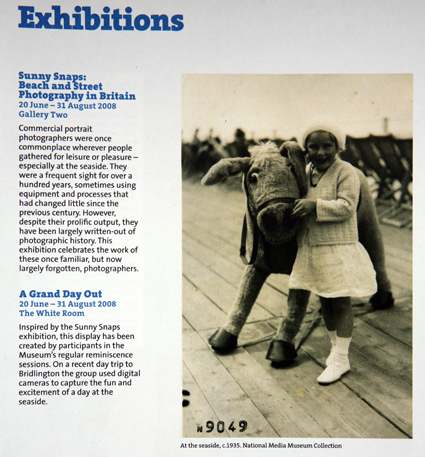
As the accompanying essay to the exhibition states, these photographers were a frequent sight for over a hundred years, sometimes using equipment and processes that had changed little since the previous century. However, despite their prolific output, they have been largely written-out of photographic history.
It’s an enlightening and often humorous exhibition which tracks the history of the genre from the independent operators using special ‘while-you-wait’ cameras on tripods to the photographers using hand-held ‘reflex’ cameras and the beach photographers who adopted various gimmicks such as the ‘head-through-the-hole’ novelty photograph which first appeared in the 1890s.
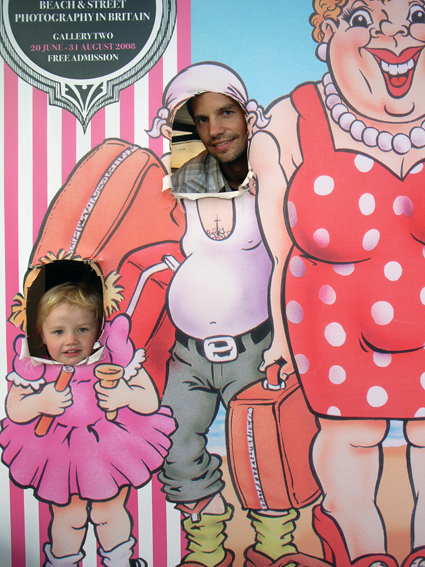
Jemima and I in a ‘head-through-the-hole’
Also worth a look is the exhibition Live by the Lens. Die by the Lens, which explores the complicated relationship between stars, publicists, photographers and the media. Of particular interest are examples of some of the earliest paparazzi pictures (Greta Garbo on holiday in Italy, Elisabeth Taylor and images by the photographers who pursued Charlie Chaplin as early as the 1930s).
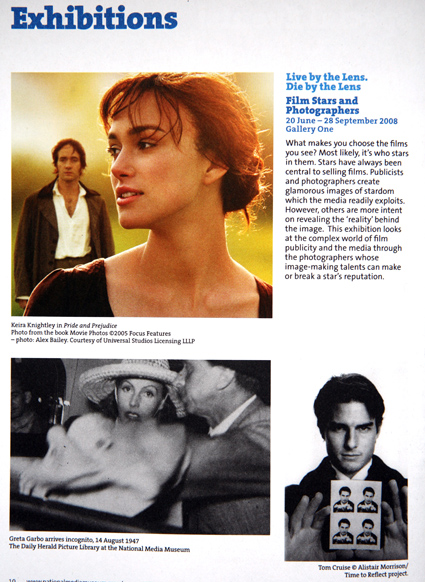
‘Sunny Snaps’ is showing in Gallery Two until 31st August 2008.
There’s also an opportunity to post up some of your own photos from seaside holidays, you have enjoyed with friends or family. These can be uploaded onto the museum’s Flickr group.

‘Live by the Lens. Die by the Lens’ is showing in Gallery One until 28th September.
Â
Posted in RESEARCH | Comments Off on SUNNY SNAPS @ NATIONAL MEDIA MUSEUM

Need I say more!
Â
Posted in TRIP LOGISTICS | Comments Off on FIVE DAY FORECAST














